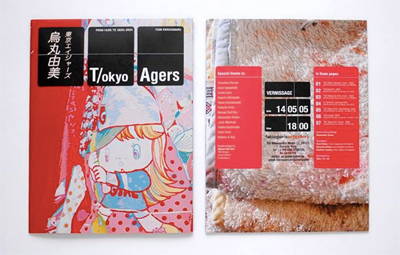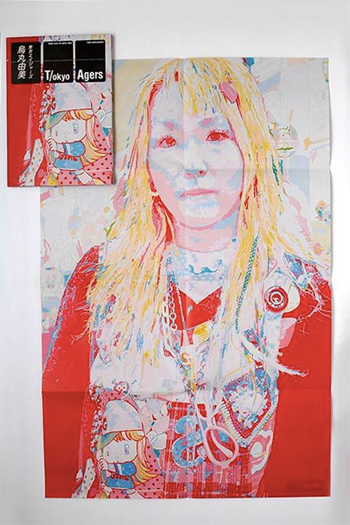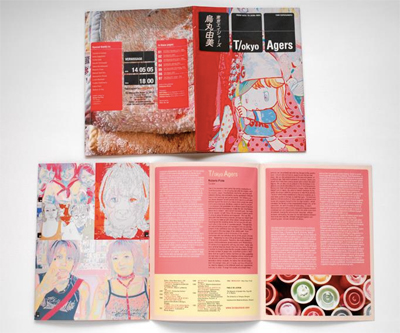From the catalog of the personal exhibition "BUNSHIN- everyday life"
at Mizuma Action (Mizuma Art Gallery) Tokyo 2006

Hidden Senses: The Essence of Karasumaru's Paintings
Takuo Komatsuzaki
Chief Curator
Hiroshima City Museum of Contemporary Art
Japanese high school girls, i.e. teenagers have occasionally been the perfect subject matter for artists. For example, the Australian artist Patricia Piccinini who attracted much attention recently at the Venice Biennial has produced a work in which a small truck-shaped object was installed with a screen in front featuring conversations and images of high school girls interviewed in Japan. In the screen, high school girls caught on the streets of Shibuya – a favorite hang out in Tokyo among teenagers – dressed in typical school uniforms and wearing distinctive make-up are talking happily with a carefree expression according to the provided script. Their appearance gives an extremely fresh and energetic impression quite different from the exhausted Japanese 'salarymen' (white-collar workers) in grey suits. Yet the girls' make-up is certainly not beautiful according to normal standards and their style of dressing – hideously short skirts and strangely loose white knee socks – could not be seen as good taste. And most of all their figure – describable positively as healthy looking but waist-less bodies with fat legs negatively – unfortunately does not seem to meet the aesthetic standards as motifs for artworks. Nevertheless, there is a sense of power – a strange free-and-easy power – in the insolent appearance of these girls sitting, gathering and talking on the streets as if nothing exists to threaten them. This strange brightness is what seems to attract artists.
Likewise appearing to have been fascinated by the look of such girls, Karasumaru has produced portraits of high school girls using her distinctive painting method in recent paintings. However, Karasumaru's choice of these teenagers as subject is not to depict a typical Japanese urban culture nor merely as an object of curiosity. This is immediately comprehensible when one sees her previous works.
The images that often appear in Karasumaru's paintings using family photos as well as in her performances are not imagery reflecting cultures of the past or the conditions of a particular era. Instead they are the shapes – or pieces – of emotions tied to fragmented memories and personal events. An emotional sensory world is actually hidden here – a world based on a theory completely different from the seemingly identical elementary view of painting based merely on a technical interest. Thus one should not see Karasumaru's work simply as a technical painting.
We can presume from this sensorial quality of Karasumaru's work that the chosen teenagers are not merely a depiction of cultural trends. In fact, a serious reality – an unbearable laceration – is hidden behind the carefree-looking girls. School entrance exams, job hunting – the real world is discriminating and the hierarchy among high schools follow throughout their lives, becoming labels for selection at all phases. These labels that seem to determine the majority of their lives are absolutely crucial for them. Suicides and murders – the real world is filled with evil spells, and it is perhaps inevitable that our souls cry pitifully to escape from them, leading us to commit such inhumane acts. This is exactly why the teenage girls laugh carefreely, happily showing off their 'peace signs'. Such an invisible world seems to be hidden under the blank white removed background of Karasumaru's paintings.
Karasumaru approaches the teenage girls on the streets, photographs them herself, and paints based on these photographic images. In the process of interviewing these girls, mixed emotions of the artist herself should consciously or not, inevitably enter the sensorially selected motifs (i.e. the girls). She does not treat such emotions overtly though, as in an expressionist manner for instance, but on the contrary depicts them perseveringly in a very stoical method – a method that may be described as an extremely Japanese manner.
Her painting starts by carefully tracing the contours of the colours of the photographic image projected on to the canvas with a projector – a work of perseverance. Keeping sensory elements to a minimum, she traces the lines as they are. A colour area map based on detailed lines eventually appears on the canvas. These lines are then filled with colour. At this point, the colours are never selected logically. Instead of using digital tools such as computers, a traditional handmade analogue method is employed and the colours are chosen intuitively by the artist herself. When these colour areas finally appear, her senses imbued with patience are partially released and try to move wildly on the canvas.
Yet according to the method of her painting, it may be difficult to simply detect these senses on the canvas. The controlled pale colours that look like design and expressions resembling photographic solarization do not reveal such emotional attachments. Thus we need to look carefully at the senses underneath the surface appearing to be in perfect order.
The core of Karasumaru's paintings is definitely not the techniques nor the beauty of colours visible on the surface. These elements are more like the instinctive sense of smell arousing within the artist when she chooses to depict sentimental emotions, subject matters and colours. The viewer should fix their eyes on this essence of her paintings – just as one reads the childish faces hidden under the heavy make-up of the teenage girls on the canvas and the real anguish erased by their carefree laughter.

ひそやかな感覚〜烏丸の絵画の本領について
小松崎拓男
広島市現代美術館学芸課長
日本の女子高生、すなわちティーン・エイジャーの姿は、時折アーティストにとって格好の題材となるらしい。例えば、先頃ヴェネチア・ビエンナーレで話題となったオーストラリアの作家のパトリシア・ピッチニーニなどは、小さなトラックのオブジェの前にスクリーンを配置し、そこに日本で取材した女子高校生の会話と映像を流すという作品を制作したことがある。画面上では、東京の渋谷というティーン・エイジャーたちが好んで集まる街角で見つけた典型的な制服姿とメイクをした女子高生たちが、屈託のない表情で楽しそうに与えられた台詞を話している。 その様子は何やら疲れ果てた灰色のスーツを着込んだ日本のサラリーマンとは違って、実にいきいきとしてエネルギーに満ちた印象を与える。それにしても一般の美しさの基準からいえば、決して美しいようには思えないメイクではあるし、スタイルだって恐ろしく短いスカートや妙にダブダブとした白いハイソックスと、いわゆるセンスのいいファッションとはいい難いだろう。そして何より体型が、よくいえば健康的、悪くいえば寸胴の身体に太い足と、残念ながら美しさという意味においては、およそ作品制作のモチーフとはなり得ないようにも感じる。しかしながら、恐いものは何もないようなごとくに路上に座り、たむろし、会話している傍若無人な姿に、何か妙にあっけらかんとしたパワーを感じない訳でもない。おそらくこうした不思議な明るさが魅力となったアーティストを引き付けるのだろうか。
烏丸もこうした彼女たちの姿にある魅力感じているのか、最近の絵画の仕事の上で女子高生たちの肖像を独自の絵画技法を用いて制作している。しかし、烏丸がこうしたティーン・エイジャーの姿を題材として取り上げるのは、日本のティピカルな都会的風俗やとしてや、それらに対する単なる好奇の目ではないだろう。何故なら彼女のこれまで制作してきた作品を見ればそれは直ちに了解されるに違いないからである。
家族の写真を使用した絵画作品やパフォーマンスにおいてしばしばあらわれる図像は、過去の風俗や時代状況を映した映像ではない。切れ切れになった記憶や個人の身の上に起こった出来事の回りに纏わりつく情念の形象であり、断片ともいうべきものであろう。ここには、一見全く同じように見える単純な技法的な興味でのみ成り立つような初歩的な絵画観とは全く別種の考え方によって成り立つ情緒的で、感覚的な世界が、実は潜んでいるのである。従って、烏丸の作品を単なる技法の絵画と見なしてはならないだろう。
このように感覚的であることを信条とする烏丸の仕事に質から推し量れば、選ばれたティーン・エイジャーたちは単なる風俗の描写ではない。実際、あっけらかんと見える彼女たちの抱える現実は深刻であり、堪え難いほどの苦悩が背後に隠れている。受験、就職、現実社会は差別的であり、彼女たちの通う高校のヒエラルキーは厳然として彼女たちの人生の前に立ち現れ、あらゆる局面で選別のためのレッテルとなる。人生のほとんどすべてを決するがごとくのそれは、まさしく決定的なものであるのだ。自殺や殺人。どのように考えても現実の世界は呪縛に満ちており、これらから逃れるためには、魂が痛ましい叫びを上げて、このように人の道を外れていくのは、必然とも言えるかも知れない。だからこそ彼女たちは屈託なく笑い、明るくピースサインを示すのだ。白く抜けた烏丸の絵の背景には、こうした見えない世界が潜んでいるように感じられる。 烏丸は、この彼女たちを街で取材し、自らの手で写真を撮影し、この映像をもとに作品を描く。女子高生たちと会話し、感覚的に選び取られるモティーフとしての彼女たちの中にこのような取材の過程で、意識するとしないとに関わらずさまざまな烏丸自身の情動が忍び込むに違いない。しかし彼女はこれをあからさまに、例えば表現主義的に現わそうとはせずに、これは極めて日本的な所作といえるのかも知れないが、むしろそれとは全く反対に、忍耐に満ちた、極めてストイックな方法によって絵画化する。
まず、彼女の絵画制作はプロジェクターによってキャンバスに写し出された映像の色彩の輪郭を丹念に写し取ることから始まる。忍従の作業である。感覚的な要素をぎりぎりまで抑制し、あるがままの線を写し取り、やがて画面には詳細な線による色面の地図があらわれる。その線を色彩が埋める。この時、決して色彩はロジカルに選ばれることはない。むしろ極めて感覚的に、コンピュータのようなデジタル・ツールが用いられるのではなく、彼女自身がまさにハンド・メイドのアナログ的で古風な描法、すなわち直感的に選ばれていく。ようやくこの色面があらわれる時、彼女の忍耐に満ちた感覚の一部が解放され、キャンバス上を奔放に動き回ろうとするのである。
だがしかし、彼女の絵画の作法に従えば、これらの感覚をただ単純に画面の中から嗅ぎ取ろうとすることは困難かも知れない。抑制され、デザイン的にも見える淡い色彩や、写真のソラリゼーションのような表現方法には、こうした情念の纏わりつきが浮き出てはこない。従って、彼女の絵画を見る時は整頓されたように見える表面の下に潜む感覚を注意深く見つめなければならないだろう。
烏丸の絵画の核心は決してその表面の上にあらわれる技法や色彩の美しさではない。むしろそれはセンチメンタルな情動や主題や色彩を選び取るときに彼女の中に沸き起こる直感的な嗅覚のようなものだろう。見るものはこうした彼女の絵画の本領を、画面の中の女子高生たちの厚化粧の下にある隠れる幼い顔と明るい笑いに打ち消された現実の苦悩を読み取るように、見据えなければならない。

Il significato nascosto: L'Essenza della Pittura di Karasumaru
Takuo Komatsuzaki
Capo Curatore
Hiroshima City Museum of Contemporary Art
Le studentesse delle scuole superiori giapponesi, le teenager insomma, sono state di tanto in tanto soggetto ideale d'ispirazione per gli artisti. Per esempio, l'artista australiana Patricia Piccinini che recentemente ha ricevuto molta attenzione all'ultima edizione della Biennale di Venezia, ha realizzato un lavoro in cui un piccolo oggetto a forma di carrello è stato installato di fronte a uno schermo su cui apparivano dialoghi e immagini di studentesse delle scuole superiori intervistate in Giappone. Sullo schermo, le studentesse fermate per le strade di Shibuya, uno dei luoghi preferiti dove farsi vedere delle teenager di Tokyo – vestite con le tipiche divise scolastiche e truccate in modo da farsi notare, parlano allegramente e in modo spensierato secondo il copione previsto. Il loro modo di apparire trasmette un'impressione di estrema freschezza ed energia, piuttosto differente da quella dei "dipendenti" giapponesi esausti (gli impiegati) nei loro abiti grigi. Eppure il trucco delle ragazze non è certamente bello secondo i canoni normali e lo stile del loro abbigliamento – le orribili minigonne e i calzettoni bianchi che cadono – non possono certo essere considerati di buon gusto. E il loro modo di apparire– che può essere descritto in termini positivi per l'aspetto di buona salute ed in termini negativi per la figura a forma di tronco e le gambe grasse – sfortunatamente non sembra essere in linea con i canoni estetici dell'arte. Tuttavia, emana un senso di potere – un potere strano e anticonformista – nel modo insolente di queste ragazze di stare sedute insieme a chiacchierare per strada, come se non esistesse nulla al mondo che potesse in alcun modo minacciarle. E' questa strana gaiezza che sembra attrarre gli artisti. Per questo stesso motivo anche Karasumaru sembra sia stata affascinata dai modi di queste ragazze. Nei suoi recenti lavori ha realizzato ritratti di ragazze delle scuole superiori utilizzando una sua personalissima tecnica pittorica. La scelta artistica di Karasumaru di scegliere come soggetto queste adolescenti non è stata però dettata dal desiderio di rappresentare la tipica cultura urbana giapponese, nemmeno come oggetto di curiosità. Lo si capisce immediatamente guardando i suoi lavori precedenti. Le immagini che spesso appaiono nei dipinti di Karasumaru sia nell'uso di foto di album di famiglia, sia nelle sue performance, non si ispirano a temi che riflettono la cultura del passato o le condizioni di un particolare periodo storico. Sono, invece, la forma – o i pezzi – di emozioni legate a frammenti di memoria e ad eventi personali. Un mondo di emozioni sensoriali che qui, in verità, è nascosto – un mondo che si fonda su una teoria completamente differente dalle apparentemente identiche ed elementari visioni pittoriche di puro interesse tecnico. E dunque, non si dovrebbe guardare al lavoro di Karasumaru semplicemente come a una tecnica pittorica. Possiamo presumere da questa qualità sensoriale del lavoro di Karasumaru che la scelta delle adolescenti non sia la mera rappresentazione di una tendenza culturale. Infatti, una realtà dura – una insostenibile lacerazione – si cela dietro l'aspetto spensierato delle ragazze. Gli esami di ammissione alla scuola, la ricerca di un lavoro – il mondo reale è discriminante e la gerarchia delle scuole superiori permane nel corso delle loro vite, diventando un'"etichetta" di selezione in tutti i loro percorsi. Queste "etichette" che sembrano determinare per la maggior parte la loro vita sono assolutamente critiche per loro.
Suicidi e assassinii – il mondo reale è pieno di seduzioni demoniache e forse è inevitabile che le nostre anime piangano pietosamente cercando una via di fuga e ci conducano a commettere atti disumani. Ecco perché le teenager ridono spensieratamente, mostrando allegramente i loro "segnali di pace". Un tale mondo invisibile sembra essere nascosto sotto lo sfondo vuoto, bianco e lontano (rimosso) dei dipinti di Karasumaru.
Karasumaru avvicina le adolescenti per le strade, le fotografa lei stessa e dipinge partendo da queste immagini fotografiche. Nell'intervistare queste ragazze le emozioni dell'artista stessa si muovono, consciamente o meno, entrando inevitabilmente nei soggetti selezionati sensorialmente (cioè le ragazze). L'artista non rivela però le sue emozioni apertamente, come nello stile espressionista per esempio, ma, al contrario, le rappresenta con perseveranza attraverso un metodo molto stoico – un metodo che può essere definito estremamente giapponese.
Inizia a dipingere tracciando in modo molto accurato i contorni dei colori delle immagini fotografiche proiettate sulla tela con un proiettore – un lavoro di perseveranza. Mantenendo gli elementi sensoriali al minimo, traccia le linee così come sono. Queste linee vengono poi riempite con il colore. A questo punto i colori non vengono selezionati in modo logico. Invece di usare strumenti digitali come il computer, viene utilizzato un metodo manuale analogo e i colori vengono scelti intuitivamente. Quando alla fine queste aree colorate appaiono, i sensi dell'artista imbevuti di pazienza vengono parzialmente rilasciati nel tentativo di lasciarli muovere istintivamente sulla tela.
Tuttavia nella modalità pittorica di Karasumaru può risultare difficile rilevare con facilità le percezioni sensoriali espresse dall'artista sulla tela. I colori pallidi e controllati che ricordano forme ed espressioni solarizzate non rivelano il forte coinvolgimento emotivo dell'artista. Così dobbiamo guardare con attenzione ai sensi nascosti sotto la superficie in perfetto ordine della tela.
Il punto dei lavori pittorici di Karasumaru non è decisamente la tecnica e nemmeno la bellezza dei colori sulla tela. Questi elementi rassomigliano di più al senso istintivo del fiuto che si risveglia nell'artista quando sceglie di ritrarre le emozioni dei sentimenti, i soggetti (personaggi) e i colori.
Chi osserva le opere di Karasumaru dovrebbe fissare gli occhi sull'essenza dei suoi dipinti – proprio come quando si legge il viso infantile delle sue teenager sotto il trucco pesante e la loro angoscia profonda travisata dalle risa spensierate.